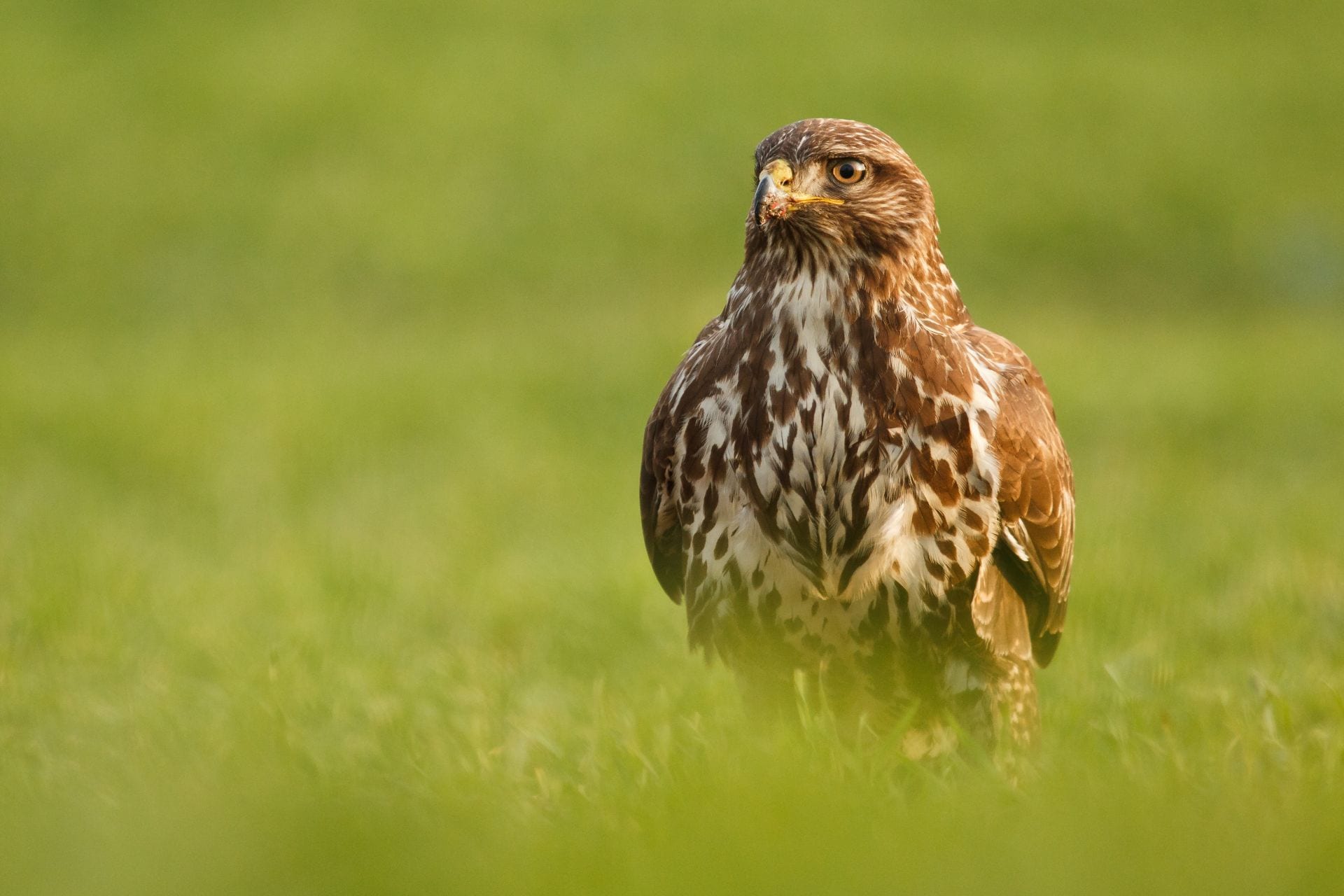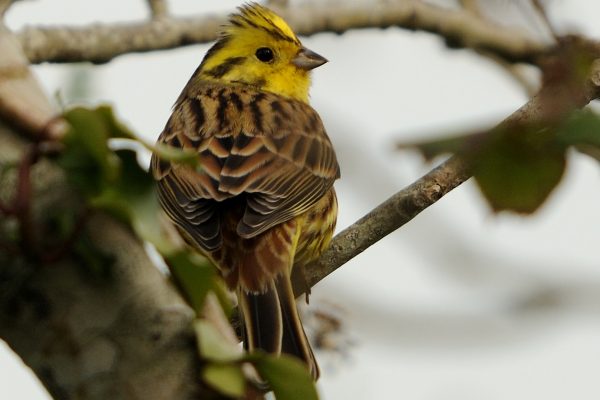
Yellowhammer
| Irish Name: | Buíóg |
| Scientific name: | Emberiza citrinella |
| Bird Family: | Buntings |
red
Conservation status
Conservation status
Status
Declining resident mainly in the east and south of Ireland. Strongly tied to cereal cultivation.
Identification
A typical bunting in size and shape (slightly larger than Chaffinch). Adult summer males are a stunning yellow colour on the head and underparts, appearing unlike any other Irish breeding bird species. Has an indistinct reddish-brown breast band and some faint black streaking along the flanks. The back and wings are brown with extensive black streaking. The rump is reddish-brown. Adult winter male Yellowhammers are much darker, with extensive black markings on the head and obvious black streaking on the breast. The head and underparts have an obvious yellow tint to them. Adult females resemble winter males, but have much less yellow on the head and underparts. Juveniles have a dark grey-brown head with an obvious white eyering.
Voice
Has several rather faint calls, which resemble those of Reed Bunting - "ziu", "plit", "pschiu". Males sing from an exposed perch in the top of a tree or hedgerow from spring to late summer. The song is a frequently repeated "sri-sri-sri-sri-sri-zu", initially increasing in pitch, before descending on the last note.
Diet
Feeds on grains of grasses and cereals. Young are fed insects.
Breeding
Formerly a widespread breeding species in Ireland, now restricted mainly to the east and south. Strongly linked with the cultivation of cereals and has declined in areas where these are no longer grown.
Wintering
Largely resident, though flocks may form in favoured feeding areas, such as winter stubble fields.
Monitored by
Blog posts about this bird

BirdWatch Ireland calls for stronger wildlife legislation and enforcement in public consultation
In recent weeks, BirdWatch Ireland welcomed the opportunity to help shape the future of wildlife legislation by making a submission to the public consultation on the review and update of Ireland’s wildlife laws.
This consultation was the first in a multi-stage process aimed at strengthening legislation to better protect biodiversity. Our submission contains many recommendations for legislative changes that support biodiversity, align with EU law and are practical and easily understood by all.
We advocated for change under 12 main headings:
- Wildlife legislation must be compliant with the Nature Directives
- Points relating to the Wildlife Act (as amended)
- Penalties for breaches of Wildlife legislation
- Birds and Habitats Regulations 2011
- Hedgerows
- The need for legislation to support a Wildlife Crime Unit
- Poison
- Open Seasons Order
- The taking of Peregrine chicks from the wild.
- Invasive and non-native species
- Technologies
- Predator control

Celebrate hedgerows and their place in our heritage and biodiversity protection this National Hedgerow Week
By Rosalind Skillen
Living walls of green, hedgerows are part of the fabric of the Irish countryside. They punctuate fields and roadsides, pulsate with life and activity, and sometimes centuries old, remind us of our rural heritage.
The role of hedgerows in biodiversity is sometimes overlooked, but essential. Hedgerows maintain and sustain wildlife diversity. They provide nesting sites, food and shelter for many bird species, including the Yellowhammer, a Red-listed Species of Conservation Concern, and Amber-listed species such as Greenfinch and Linnet.
National Hedgerow Week 2024
This week marks National Hedgerow Week in Ireland. A programme of free events is taking place across the country between Friday 30th August and Friday 6th September 2024. These events are focused on how to plant and manage hedgerows to maximise the benefits for biodiversity, climate and farmers. Speaking at the launch event for National Hedgerow Week 2024 in Birr Castle, Minister of State for Nature, Heritage and Electoral Reform Malcolm Noonan T.D. highlighted the cultural and historical significance of hedgerows: "Ireland’s hedgerows are not just a feature of our landscape; they are a living link to our past. These ancient boundaries tell the stories of our ancestors and provide a unique habitat that is central to our biodiversity. Protecting them is not just an environmental imperative but a cultural one." Minister Noonan’s comments remind us that hedgerows are more than ecological assets; they mark the passage of generations, with the lives of farmers and wildlife intertwined among their branches. However, without adequate protection, hedgerows, and the species that they protect, will be nothing more than a memory of the land.The Wildlife Acts and hedge cutting
We know that hedgerow protection is something BirdWatch Ireland members care about. BirdWatch Ireland provides a public information service via our phone and email lines, and queries around hedge cutting make up the majority of those we receive. In a 2019 survey of BirdWatch Ireland branches, “the deteriorating quality of hedgerows as habitats for birds and other wildlife due to inappropriate management, illegal cutting and removal” was voted the second highest concern for nature. Cutting back hedges during the nesting season can result in the destruction and/or disturbance of nesting sites of these and many other wild bird species. Disturbance alone may lead an adult bird to abandon a nest, leaving the eggs and chicks within likely to succumb to starvation or predation. Under the Wildlife Acts, it is against the law to cut, burn or otherwise destroy vegetation including hedges between 1st March and 31st August. The reason for the hedge-cutting ban is to prevent disturbance and destruction of nesting sites of many of our wild bird species. However, there are several exemptions under this legislation which permit hedge-cutting during the closed period, for example, in the case of road safety concerns. Additionally, if such work is carried out in the “ordinary course of agriculture”, it has blanket exemption. This year, the NPWS clarified that “horticulture” falls under the definition of “agriculture”, which would mean that the cutting of garden hedges is also exempt. This recent clarification from the NPWS is cause for concern for us as it is now our understanding that hedgerows have no true legal protection whatsoever. As hedgerows do not occur naturally and all originate as deliberate agricultural or horticultural planting, it appears hedgerows have no true legal protection as any possible manner of cutting falls under an exemption. This is a major shortcoming of the Wildlife Acts and one that is in contradiction of our requirements under the EU Birds Directive. Hedgerows are protected under the EU Habitats Directive if they are breeding sites or resting places for strictly protected species (listed on Annex IV Habitats Directive) or if they are part of protected habitat types (Annex I) or habitats of protected species (Annex II) designated as Natura 2000-sites. There are also EU farm subsidy-linked standards that give hedgerows protection as landscape features that cannot be interfered with or removed. Where removal is necessary, an equivalent length of new hedgerow must be planted in advance. Support National Hedgerow Week by:- Raising your concerns about hedgerow cutting with your local councillor or TD
- Attending one of the free events as part of National Hedgerow Week 2024
- Submitting a response to the Government review of Ireland’s wildlife legislation, and its failure to effectively protect Irish hedgerows and wild birds








